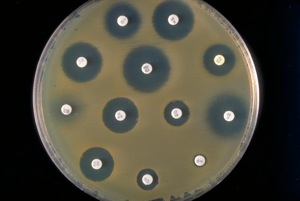
Antibacterial Drugs
last authored: Feb 2010, David LaPierre
last reviewed:
Introduction

antibiotic sensitivity and resistance
image courtesy of CDC
There are many drugs available to treat bacterial infections, with different drug types best suited for treating specific infections.
Effective diagnosis, made with a combination of clinical and laboratory findings, helps with the decision.
Emperic therapy can also be used.
Cell Wall Inhibitors
- penicillins
- cephalosporins
- carbapenems
- glycopeptides
Penicillins bind to penicillin binding proteins (PBPs), leading to distorted cell walls and lysis.
drugs |
coverage |
indications |
adverse effects |
benzyl penicillin
|
|
mild-to-moderate infections: actinomycosis, strep pharyngitis, rheumatic fever, streptococcal skin and soft tissue infections
|
|
aminopenicillin
|
|
meningitis, endocarditis, AOM, pharyngitis, sinusitis, AE-COPD, H pylori, Lyme disease, RTI, UTI often used in combination with gentamycin (gram -ve) and clavulin (for a boost) |
|
isoxozoyl penicillin
|
|
||
ureidopenicillin
|
|
||
lactamase inhibitors
|
|
RTI, sinusitis, AOM, skin/soft tissue infections, UTI |
|
carboxypenicillin
|
|
Beta-lactam resistance has evolved in a number of ways. Production of beta-lactamase, altered PBP (S. pneumoniae), new PBP (MRSA), and altered permeability can all occur.
Cephalosporins bind to penicillin binding proteins (PBPs) and prevent cross-linking of peptidoglycans, leading to distorted cell walls and lysis.
drugs |
coverage |
indications |
adverse effects |
1st generation
|
|
skin/soft tissue infections, surgery prophylaxis |
|
2nd generation
|
|
soft tissue |
|
3rd generation
|
|
RTI, gonorrhea, meningitis, septicemia, abdominal infections |
|
4th generation
|
|
emperic therapy for febrile neutropenia |
Carbapenems bind to penicillin binding proteins (PBPs) and prevent cross-linking of peptidoglycans, leading to distorted cell walls and lysis.
drugs |
coverage |
indications |
adverse effects |
imipenem
|
|
GNB with extended beta-lactamases |
|
meropenem |
Glycopeptides bind to D-ala in nascent cell wall peptides, preventing cross-linking during peptidoglycan formation.
drugs |
coverage |
indications |
adverse effects |
vancomycin
|
|
severe, life-threatening gram-positive infections |
|
teicoplanin |
|
Glycopeptide resistance can be a problem in S. aureus and Enterococcus. It occurs via an altered target: D-lac in place of D-ala.
Protein Synthesis Inhibitors
- macrolides
- aminoglycosides
- lincosamides
- tetracyclines
- other
Macrolides have a broad spectrum of activity. They are bacteriostatic, with time dependent killing.
drugs |
coverage |
indications |
adverse effects |
erythromycin
|
|
RTI, pertussis, diptheria, Legionnaires disease, skin/soft tissue infections, chlamydia |
|
clarithromycin (Biaxin) |
|
RTI, skin infections, mycobacteria, H.pylori |
|
azithromycin (Zithromax) |
|
pharyngitis, tonsilitis, AOM, AE-COPD, community-acquired pneumonia, skin infections, campylobacter |
Aminoglycosides
Aminoglycosides are excellent for gram-negatives. They are bactericidal, killing in a concentration-dependent manner.
Drugs include:
- gentamycin
- tobramycin
- neomycin
- streptomycin
- amikacin
coverage |
indications |
adverse effects |
|
|
|
lincosamides
drugs |
coverage |
indications |
adverse effects |
clindamycin
|
|
suspected or proven GP, anaerobes |
|
Tetracyclines
tetracycline, minocycline, doxycycline
coverage |
indications |
adverse effects |
|
|
|
Other
coverage |
indications |
adverse effects |
|
serious infections when suitable alternatives not available |
|
drug |
coverage |
indications |
adverse effects |
linezolid |
|
VRE, MRSA as outpatient |
|
DNA Synthesis Inhibitors
- fluoroquinolones
- other
Fluroquinolones
Fluoroquinolones act on DNA gyrase and topoisomerase IV. They are bactericidal, with concentration dependent killing. Bad for children, as DNA is important to them.
drugs |
coverage |
indications |
adverse effects |
|
|
use only when necessary to prevent resistance: RTI, UTI, prostatitis, bone and joint infections, skin and soft tissue, infectious diarrhea, intra-abdominal infections, febrile neutropenia |
|
|
|
same as above; community-acquired pneumonia |
|
Other
drug |
coverage |
indications |
adverse effects |
|
|
active TB, other mycobacterial infections; prosthetic endocarditis |
|
drug |
coverage |
indications |
adverse effects |
|
|
protozoal infections (trichomonas, amebiasis, giardiasis), bacterial vaginosis, serious intra-abdominal infections |
|
Metabolic Pathway Inhibitors
TMP/SMX blocks folic acid synthesis; bacteria cannot obtain folate from their environment and rely on its synthesis from PABA. Resistance if organism can bypass metabolic requirements.
drug |
coverage |
indications |
adverse effects |
|
|
UTR, RTI, GI infections, skin and soft tissue, PCP |
|
drug |
coverage |
indications |
adverse effects |
|
|
lower UTI; not pyelonephritis or bactermia |
|
Antimycobacterials
Always used as combination therapy (minimum three). These drugs are given over a long duration, ie 6 months or more.
drugs |
coverage |
indications |
adverse effects |
|
|
|
|
|
rifampin
|
|
active TB, other mycobacterial infections; prosthetic endocarditis |
|
ethambutol |
|
|
|
pyrazinamide |
|
||
sulfones |
|
||
clofazimine |
|
History of Antibiotic Development
Get JR to do a video for here...
Resources and References
